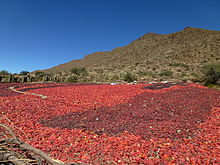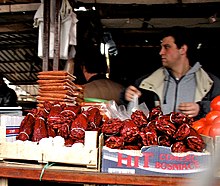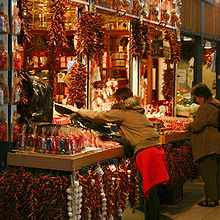Paprika





Paprika is a spice made from ground, dried fruits of the chili pepper family of the genus Capsicum annuum. Although Paprika is often associated with Hungarian cuisine the chilies it is made from are native to the New World. Spain and Portugal introduced Capsicum annuum to the Old World from the Americas.[1] Spanish pimentón, as it is known there, is often smoked, giving it a unique earthy flavor.[2][3] The seasoning is also used to add color and flavor to many types of dishes in the cuisines of Turkey, Spain, Portugal, Greece, Macedonia (FYR), Hungary, Romania, Croatia, Serbia, Bulgaria, Morocco, and South Africa.
The use of paprika expanded from Iberia throughout Africa and Asia,[4] and ultimately reached Central Europe through the Balkans, which were under Ottoman rule, explaining the Hungarian origin of the modern English term. In Spanish, paprika has been known as pimentón since the 1500s, when it became a typical ingredient of the western region of Extremadura.[5] Despite its presence in Central Europe since the beginning of Ottoman conquests, it did not become popular in Hungary until the late 19th century.[6]
Central European paprika was hot until the 1920s, when a Szeged breeder found one plant that produced sweet fruit. This was grafted onto other plants.[7] Nowadays, paprika can range from mild to hot, and flavors also vary from country to country, but almost all the plants grown produce the sweet variety.[7] The sweet paprika is mostly pericarp with more than half of the seeds removed, whereas hot paprika contains some seeds, placentas, calyxes, and stalks.[5]
In many European languages the word paprika also or only refers to the Capsicum fruit itself.
Etymology and history
The plant that makes the Hungarian version of the spice was grown from 1529 by the Turks at Buda[8] (now part of the capital of Hungary, Budapest). The first recorded use of the word "paprika" in English is from 1896.[8] It came from the Hungarian word "paprika", which was a diminutive of the Croatian language word "papar" (meaning "pepper"),[8] which in turn came from the Latin "piper" or Modern Greek "piperi".[8] Similar words, "peperke", "piperke", and "paparka", are used in various other Slavic languages in the Balkans for bell peppers.[5]
The two Spanish varieties of paprika, known in Spain as "pimentón" come from the Comarca de La Vera in Cáceres province and a variety from Murcia region, both of which were introduced from the Americas, where they originate, by local monks some time in the 1500s.
The word "paprika" entered a large number of languages, in many cases probably via German.[9] Many European languages use a similar word whilst examples from other languages include the Hebrew paprika [פפריקה] and the Japanese papurika [パプリカ].[9]
Usage

Paprika is produced in a number of places including Hungary, Croatia, Serbia, Spain, Macedonia and some regions of the United States.[10] It is used as an ingredient in a broad variety of dishes throughout the world. Paprika is principally used to season and color rices, stews, and soups, such as goulash, and in the preparation of sausages as an ingredient that is mixed with meats and other spices. In the United States, paprika is frequently sprinkled on foods as a garnish, but the flavor is more effectively produced by heating it gently in oil.[11]
Spanish Paprika (pimentón) is available in three versions, mild (pimentón dulce), moderately spicy (pimentón agridulce), and very spicy (pimentón picante.) Some Spanish paprika, including pimentón de la Vera has a distinct smoky flavor and aroma as it is dried by smoking, typically using oak wood.[12]
Hungary is a major source of paprika and is thus more commonly used. It is available in grades ranging as follows:
- Special quality (Különleges) the mildest, very sweet with a deep bright red color.
- Delicate (csípősmentes csemege) – color from light to dark red, a mild paprika with a rich flavor.
- Exquisite Delicate (Csemegepaprika) – similar to Delicate, but more pungent.
- Pungent Exquisite Delicate (Csípős Csemege, Pikáns) – an even more pungent version of Delicate.
- Rose (Rózsa) – pale red in color with strong aroma and mild pungency.
- Noble Sweet (Édesnemes) – the most commonly exported paprika; bright red and slightly pungent.
- Half-Sweet (Félédes) – A blend of mild and pungent paprikas; medium pungency.
- Strong (Erős) – light brown in color, the spiciest paprika.[13]
Hungarian Paprika is often specified in recipes because it is unique. It is bright red and said to be sweeter than the same paprika grown in other soils and climates. Other paprika types have their unique niche, so it is important to use the type of paprika specified in recipes (if specified), unless it is used in small quantities. In "paprikash" (paprika gravy, a combination of broth, paprika, and sour cream), paprika is used by the tablespoonful. In such instances, Hungarian Paprika is preferred.
"The Hungarian varieties are more robust and considered superior. The Spanish varieties are sweeter and milder. Most tables in Hungary are set with salt and hot paprika (not black pepper) shakers. One particular variety, the 'rose', known for its sweet aroma and brilliant color is prized above all others. Hungarian agricultural authorities fiercely guard their plants and seeds and twice as much acreage is devoted to peppers as any other crop."[14]
"Due to the favourable climate and geographical conditions Hungarian paprika has a bright red colour and a distinctive rich flavour that allowed Hungary to became one of the leading paprika producers in the world...Kalocsa and Szeged in the southern part of Hungary are the heart of paprika production in Hungary. These regions have the highest amount of sunny hours a year and paprika plants need lots of sunshine to get ripe and sweet."[15]
The Netherlands is a major production and distribution source of paprika as well, especially grown in greenhouses.
In Moroccan cuisine, paprika (tahmira) is usually found slightly moistened by the addition of a small amount of olive oil blended into it.
Paprika can also be used with henna to bring a reddish tint to hair when coloring it. Paprika powder can be added to henna powder when prepared at home.
The color of paprika is primarily due to the xanthophyll carotenoid zeaxanthin.
Nutrition
According to the USDA, 1 tbsp (6.8 g) of paprika has the following nutritional content:[16]
- Calories: 19
- Fat: 0.88 g
- Carbohydrates: 3.67 g
- Fiber: 2.4 g
- Protein: 0.96 g
See also
- Ajvar
- Capsicum
- Cayenne pepper
- Crushed red pepper
- List of Capsicum cultivars
- List of smoked foods
- Paprika Tap de Cortí
- Pimento
References
- ^ Emmons, Didi, Vegetarian Planet: 350 Big-Flavor Recipes for Out-Of-This-World Food Every Day, p. 437
- ^ Simply Bill - Bill Granger. p. 49.
- ^ Raising the Bar: Better Drinks Better Entertaining - Nick Mautone. p. 215.
- ^ Peppers: The Domesticated Capsicums - Google Books. Books.google.co.uk. Retrieved on 2013-09-20.
- ^ a b c Peppers: The Domesticated Capsicums, pp. 5 and 73
- ^ The Glutton's Glossary: A Dictionary of Food and Drink Terms, p. 205
- ^ a b Paprika: A Spicy Memoir from Hungary, p. 202
- ^ a b c d "Online Etymology Dictionary". Etymonline.com. Retrieved 2011-11-04.
- ^ a b Katzer, Gernot (May 27, 2008). "Paprika (Capsicum annuum L.)". Retrieved December 1, 2012.
- ^ "Paprika — Food Facts". Food Reference. Retrieved 2011-11-04.
- ^ Hyde, Brenda. "Classic Spice Blends: Paprika". Oldfashionedliving.com. Retrieved 2011-11-04.
- ^ "Spanish Paprika — Pimentón". Spanishfood.about.com. 2011-03-02. Retrieved 2011-11-04.
- ^ by Tom (2008-10-31). "Grades of Paprika | The Spice House Blog". Retrieved 2011-11-04.
- ^ Chefs Corner | Red Cat Restaurants | New York City. Red Cat Restaurants. Retrieved on 2013-09-20.
- ^ Hungarian Paprika-Facts, History & Recipes. Budapest-tourist-guide.com. Retrieved on 2013-09-20.
- ^ NDL/FNIC Food Composition Database Home Page. Nal.usda.gov. Retrieved on 2013-09-20.
External links
- Nutrition Facts and Analysis from NutritionData.com
 The dictionary definition of paprika at Wiktionary
The dictionary definition of paprika at Wiktionary
